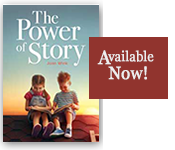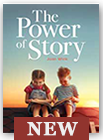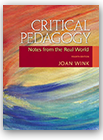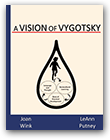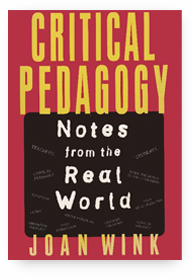HISTORY HELPS: THREE PERSPECTIVES
History helps us understand why we do what we do. We are a reflection of all that has gone before us; we are indebted to the people and the ideas that have preceded us. When I started teaching in 1966, the world was a very different place. I do things very differently in my classes now, but I know that what I do in classes every day is touched by all the teaching, learning, and believing that has preceded me. Looking back historically can illuminate our present as we run to catch the future. In what follows, we will examine three approaches that represent unique educational beliefs and behaviors.
Transmission Model
The teacher is standing in front of the classroom, and the students are at their seats, which are in rows. They listen to what she says and write it down in their notebooks.
“A carrot is a root. We eat many roots. It is orange, and it is good for you. Other roots we eat are onions, beets, jicama, potatoes. Class, are you writing everything that I tell you? Today I will classify plants to those you can eat and those you can’t. Make two columns on your paper and be sure to get every word I say for your homework. You will have a test on these exact words tomorrow. Who can name some other roots that we eat?”
I suspect that every one of us has had a similar experience. Were you taught this way? Do you teach this way? Why? For centuries, the vision of the teacher in front of the class pouring knowledge into students’ heads guided the image of pedagogy. In this instructional model, the teacher has the knowledge, and the students receive that knowledge. The teacher’s job is to transmit knowledge. The teacher controls who knows what; power has always been a part of pedagogy.
I began my career in much the same way; I taught the way I was taught. In fact, I was a true eight-year-old direct instruction specialist, maybe even a zealot. I made my girlfriends sit on the basement steps, and; I stood on the cement floor below, and I taught. Oh, did I teach! I spoke; they listened. I had the knowledge in my head, and all I had to do was transmit it to them. What power. I could control their knowledge. For evaluation, they had to give it back to me exactly the way I gave it to them. Why in the world did they ever come to play with me? Fortunately, since the days of stair-step pedagogy, we have learned a lot about teaching and learning, not to mention the fact that the world has changed, too. Politically, economically, scientifically, ecologically, culturally, demographically, those days are gone. That was then; this is now.
Today, we have more complex understandings of who students are and how they learn. This new knowledge has raised questions about the traditional way of transmitting previous knowledge. Educators and researchers increasingly recognize the role students play in constructing knowledge and accessing new knowledge. The teacher-directed lesson too often lacks opportunities for students to interact with one another and with the ideas that they are studying. In addition, in linguistically diverse classrooms, the teacher-directed lesson is often incomprehensible to students who are still learning English. Students can’t learn what they don’t understand. Me, either.
To address these problems, more and more educators focus their pedagogy on discovery, exploration, and inquiry. Although intrigued by these ideas, many teachers find themselves at a loss in terms of how to structure these kinds of learning experiences in their crowded classrooms.
Generative Model
Now, imagine a classroom with small groups of students clustered around various learning centers. At each center students are exploring the properties of edible roots. One group is cutting a potato, a carrot, and an onion and dropping iodine on the pieces to see if they contain starch. Another group is sorting through an array of vegetables to determine which are edible roots. At still a third center, a group is setting up jars to sprout potatoes. The teacher moves around the room, quietly observes, and periodically interacts with various groups.
The teacher moves to the group that has jars for sprouting potatoes. “I see your group has used different amounts of water in your jars. Can you predict which potato will sprout first? Why?”
The generative model maintains that students must actively engage in their learning process. In this model, students come together and construct or build their own knowledge. Learning is not passive. Students generate meaning as they integrate new ideas and previous knowledge. Simply put, students are participants in their own learning. The teacher’s job is to structure and guide classroom experiences that will lead to student learning.
Transformative Model
Now, let’s visit another classroom that is also studying carrots, and onions, and roots. The educational model that is being used in the following classroom is historically rooted in the transmission and generative models. However, this model reflects, not only the changing world, but also our more complex understandings of meaningful teaching and learning. This model reflects today and prepares for tomorrow.
Imagine a classroom where small groups of students are outside working in their garden, which they planted several months ago. The students are digging the potatoes, carrots, and onions and weighing them. Based on their production costs, the students will determine their price per pound later in math class. The group has decided in their class meeting that they will sell a portion of the roots in order to earn money for the scholarships for a field trip. The remainder of the garden vegetables will be donated to the local food kitchen (Wink & Swanson, 1993).
In transformative pedagogy, or critical pedagogy, the goal includes generating knowledge, and extends from the classroom to the community. Good constructive pedagogy often stays inside the classroom. Critical pedagogy starts in the classroom, and goes out into the community to make life a little better. Some would say that this group of students is doing critical pedagogy.
Transmission to Transformative: An Example
Recently, I had an experience at the post secondary level with these three approaches: transmission, generative, and transformative. My goal was to share that immersion has many simultaneous and contradictory meanings often resulting in misinformation, disinformation, (see Note 1) and harmful consequences for many language minority students. The public doesn’t understand this. Many educators are confused about these multiple meanings, which result in very distinct programs and theoretical underpinnings.
This particular group of adult graduate students had already been working hard for several hours with me, so initially I explained that I had one more concept I wanted them to understand. It was important. If they were too tired, we would wait until the next day. No, they were ready, let’s go.
I am sure that some would describe this as an anticipatory set from the 5-step lesson plan. Some would say that I was working to establish motivation. Maybe. However, I believe learning is about ownership. It is about making meaning together. It is about socially-constructing knowledge. It is about experiencing. It is not about being talked at. If learning is not meaningful to students, it is irrelevant what the teacher does Students have taught me this through the years. So did Dewey. So did Vygotsky. By the time I began the following lesson, the students owned their learning and were ready to experience a new idea.
Previously, I had made a chart to capture the three models of immersion and other dual languages programs, as seen in Figure 4.1. I reflected on various pedagogical approaches I could use.
| Program | Goals | Students | Teacher Preparation |
Time |
| French Canadian Immersion |
1.) English and a second language(bilingualism/biliteracy) 2.) High academic achievement |
Language Majority Population |
Credential | K-6 |
| Structured English Immersion |
English Only | Language Minority Population |
English Only | 9 Months |
| Bilingual, Dual, orTwo-way Immersion |
1.) English and a second language(bilingualism/biliteracy) 2.) High academic achievement 3.) Positive cross-cultural relations |
Language Majority & Minority Populations |
Credential | K-6 |
| Maintenance/ Enrichment Bilingual Education |
1.) English and a second language(bilingualism/biliteracy) 2.) High academic achievement 3.) Positive cross-cultural relations |
Language Majority & Minority Populations |
Credential | K-6 |
| Transitional Bilingual Education |
English Only | Language Minority Population |
Credential or Paraprofessional Support |
As fast as Possible |
FIGURE 4.1: Dual Language Models
First, I knew I could use the transmission model. It would be fast (for all of us) and efficient (for me). I could simply lecture on the information or give them the handout and tell them to read it. Then, they could memorize what I had given them, and I could test them on the knowledge. I knew they would all get good grades on such a test, but I also knew that the information would not be meaningful and relevant. Nor, would they remember it.
Second, I thought about a more interactive approach; I wanted the students to be socially constructing meaning as we worked our way through immersion. I wanted them to talk to each other; to ask questions; to slow me down. I decided to use a generative or constructive approach to sharing the information. I had a very large and very long piece of paper that covered the entire front of the wall. On this paper I had drawn the chart as seen in Figure 4.2, however I drew only the framework of the chart.
I drew it all with a black marker. Under the program column, I wrote French Canadian immersion in red; bilingual (dual language) immersion in green; and structured immersion in blue. As immersion models were the focus of this lesson, I wrote the other program models in black. I did not fill in the information on goals, students, teacher preparation, or time for any of the program models. The empty spaces were waiting for us to generate or construct the knowledge together.
Of course, I was hoping that the class would also begin to generate other dual language models after they understood the three immersion models. First, I was interested to see if they would discover the parallels between dual language immersion and maintenance bilingual education. Second, I wanted to see if they would discover the difference between French Canadian immersion and dual language immersion.
| Program | Goals | Students | Teacher Preparation |
Time |
| French Canadian Immersion |
||||
| Structured English Immersion |
||||
| Bilingual, Dual, or Two-way Immersion |
||||
| Maintenance/ Enrichment Bilingual Education |
||||
| Transitional Bilingual Education |
FIGURE 4.2:Constructing the Models
Let the dialogue begin.
KWL
We began with a K/W/L approach. What did the students know (K)? What did they want (W) to know? How might they learn (L) it?
K (know): The students talked in small groups about what they knew about immersion. They shared with the whole group. We recorded their prior knowledge on the chart and were able to fill in some of the blanks.
W (want to know): They wanted to know about the empty blanks. They wanted the information about immersion that they couldn’t generate together.
L (learn): Usually students learn in various modes: from books, interviews, videos; on the Internet; at the library; from conversations with their families and friends; by collecting their own data, and so on.
Given the context (we had all been working very hard together for several hours; it was late, and I was exhausted), we decided that I would share the information with them as I have experienced all three of these models. When we were finished, our chart reflected the following, as previously seen in Figure 4.1:
First: French Canadian immersion is a term used in the United States to refer to a program that serves language majority students. The goals are English and another language (bilingualism/biliteracy) and high academic achievement in seven (K-6) years. The teachers are credentialed or certified bilingual or multilingual teachers. It has a long successful history in Canada.
Second: Structured English immersion (or as it is sometimes called in California, sheltered English immersion, structured English immersion, or even English immersion) is very different from the Canadian model. It is designed to serve language minority students. The goal is English dominance within one year. Teachers or paraprofessionals need not speak the language of the students, and the language of instruction is overwhelmingly in English (Krashen, Summer/Fall, 1998).
Although this model is programmatically and philosophically the exact opposite of the French Canadian model, the public often thinks they are the same. In addition, some politicians perpetuate this myth for their own political agenda, which happened in California in June 1998 with the passing of Proposition 227: English for the Children. The public was asked if they wanted their children to speak English. Of course, they did. However, if the proposition had been written differently, for example, do you want your children to speak English AND receive primary language support in content areas while learning English, perhaps, the results would have been different as is reflected in Krashen (1998, August) (see Note 3).
Other states are exploring comparable initiatives. For me, this seems to be a classic example of taking a very complex (social-cultural-pedagogical-linguistic-educational-political) issue and presenting it in a simplistic manner. It all reminds me of the old saying: For every complex issue, there is an answer that is obvious, simple, and wrong (see Note 3).
In my life I have noticed that voting on initiatives and propositions can be very confusing. Sometimes the wording leads me astray, and I have a hunch that someone is trying to fool me. In addition, I have noticed that sometimes the title of a proposition is the opposite of what it is really about. Because of this, I always vote absentee ballot so I can sit at home and think carefully. I don’t want to be tricked or trapped. Because of my cautious nature, and because I care a lot about kids, and ideas, and words, I have developed the following rules:
Yes means no.
No means yes.
For example, Proposition 227 was named English for the Children. So, when I read that, I thought, Yes. And, when I think yes, that means I have to vote no. English for the Children: You bet. Of course, we all want English for the children.
Rule #2
Left means right.
Right means left.
I recently heard someone (whom I considered to be a right-wing person) say that his opponent (whom I considered to be a left-wing person) can’t get left of him on this one. What?
All of this makes for interesting and lively family conversations, at least in our family. For example, I am a professor and a registered Democrat; my husband is a rancher and a registered Republican. We used to know the rules. We knew which were his issues and which were mine. And we sure knew left from right. Now it seems that we have all new rules to relearn and even unlearn. An old Chinese proverb is true for us today: We are blessed and cursed to be living in such interesting times. It is a new day. In fact, it is a turn of the century – time for all of us to find ideas that reflect our new world. Even ranchers and professors.
Third: Bilingual (dual or two-way) immersion is designed to serve majority and minority students. The goals are English AND another language (bilingualism/biliteracy), high academic achievement, and positive intergroup relations in seven (K-6) years. The teachers are credentialed or certified bilingual or multilingual.
Together, the students had generated the knowledge on the three immersion programs, and they had gone beyond the immediate learning objective to also generate their own knowledge regarding all dual language programs. When we finished, the graduate students/teachers in this group immediately pointed out to me that the bilingual immersion model is very similar to the French Canadian model, although it differs in one profound area: The bilingual immersion model is designed to provide biliteracy for all students, not just the majority language students, as is the French Canadian model. They also pointed out that the structured immersion model is essentially the old submersion model: sink or swim. We also discussed the fact that I could have handed them the copies of the completed chart (see Figure 4.1) and told them to read it. They were confident that the more generative/constructive way, although it took longer, was more effective. They felt they knew the materials.
Of course, I wish for this to be transformative learning for the students, but I can never control what students do with their own learning. Transformation requires that we shift from passive learners to active professionals and intellectuals in our own communities.
In summary, these three perspectives are not the only ways of teaching and learning. Of course, there are many ways of understanding complex processes like teaching and learning. I very much like Sonia Nieto’s (1996; p. 319) advice to always keep the number 17 in mind as it reflects so well multiple perspectives on complex realities. Make no mistake about it: The interaction between teaching and learning, or pedagogy, is very complex. However, these three approaches (transmission, generative, and transformative) do provide a framework for us to reflect on our own pedagogy (see Note 4).
1. In the traditional classroom, instruction outcomes are often quite narrow and specific (memorized concepts, vocabulary, and skills); in the transformational model, student outcomes are as complex as the complexities of our diverse society. The problems students study and the range of possible solutions reflect the dilemmas of the larger society, and the complexity of society is mirrored in both the instructional strategies and content of classroom discourse.
2. The transformative lesson, or doing critical pedagogy, distinguishes itself in two ways from the generative, or constructive, lesson. First, it is designed so the students act upon and use their generated knowledge for self- and social transformation. The socially constructed knowledge of the classroom is to be applied in the social context of life. Second, this lesson design is inherently grounded in democratic principles.
3. The transformation model of education is another name for critical pedagogy. In this case the teacher and the students are not only doing critical pedagogy, they are living critical pedagogy. The fundamental belief that drives these classroom behaviors is that we must act; we must relate our teaching and learning to real life; we must connect our teaching and learning with our communities; we always try to learn and teach so that we grow and so that students’ lives are improved, or for self- and social transformation.
